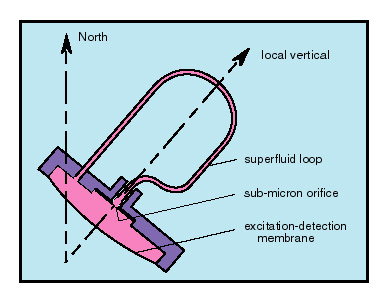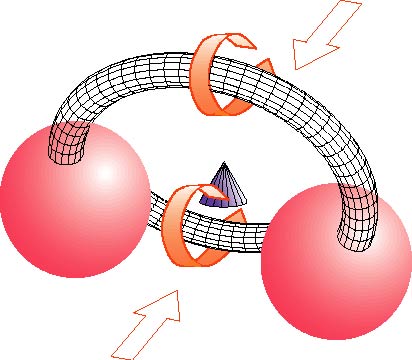
| The superfluid state, in general, is
characterized by
frictionless, highly correlated irrotational motion of the
fluid particles.
The superfluid accommodates to rotation by forming a
lattice of quantized
vortices in which the vortex core, typically singular,
breaks the topological
constraint against rotational motion. In superfluid 3He,
the structure of vortex cores can be much more complicated
than in conventional
superfluids because of the many degrees of freedom
provided by the 18-dimensional
order parameter manifold.
My work on superfluid 3He in rotation was commenced in 1978 when the construction of a nuclear demagnetization cryostat was initiated at the Low Temperature Laboratory of the Helsinki University of Technology. The cryostat, the first of its kind combining millikelvin techniques and an air bearing system, was completed in the end of 1981. At the time of the first experiments, performed using nuclear magnetic resonance techniques, no striking results were expected since vortex cores were thought to be too small to leave an imprint on the absorption spectra. However, this proved to be false and several fundamental findings on vortices in rotating superfluid 3He were obtained in these experiments: |
Also, vortices in superfluid 4He
continue to
present novel, interesting phenomena:
4He: -
Phase slips and rotation detection [PRL
78, 3602 (1997)]
-
Vortex unpinning due to quantum fluctuations in superfluid 4He
[PRL 81, 3451 (1998)]
| The first evidence for vorticity in rotating superfluid 3He was obtained in transverse NMR experiments which showed an increase in the line width, directly proportional to the rotation velocity [PRL 48, 1838 (1982)]. The line width broadening is due to vortex-induced order parameter inhomogeneity that leads either to scattering of spin waves or to enhanced spin diffusion. The linear dependence on angular velocity reflects the linear increase in the number of quantized vortices. |
| The structure of quantized vortices in superfluid 3He-A in a large field (>> dipolar field) could be deciphered on the basis of a small, well-shifted satellite peak in the NMR spectrum [PRL 49, 1258 (1982)]. The satellite peak can be explained only by doubly quantized, continuous vortices. The core size for a 4p vortex without a singularity is large enough to localize spin waves that have a sufficiently large frequency shift from the continuum in order to fit the experimental observations. |
| In rotating superfluid 3He-B, the order parameter distribution was found to be influenced by an orientational free energy term that was linear both in the magnetic field and rotation velocity (i.e. it changed sign on the reversal of either the angular velocity or the magnetic field). The magnitude of this free energy term changed abruptly at the vortex core transition. These findings clearly indicate that the B-phase vortices have an intrinsic magnetic moment [PRL 51, 1362 (1983)]. |
| Continuous vortices in the A-phase at high magnetic fields can exist with two distinct symmetries. Their energy was found to be nearly degenerate according to theoretical calculations. On the basis of experimental results it is impossible to distinguish between these two vortices: both structures have spin-wave potential wells that exhibit localized levels low enough in energy to fit the measured frequencies [PRL 52, 1802 (1984)]. |
| The phase transition between two quantized vortices was mapped in the pT-plane using magnetization and susceptibility anisotropy of the core structures [PRL 53, 584 (1984)]. Strong metastability over the re-entrantly shaped transition line was observed indicating first-order nature of the phase transition. |
| Vortex pinning was found to play a substantial role in these experiments using a stack of parallel plates to confine the helium liquid. Among other things, this confinement led to observable persistent currents in 3He-A which could be seen by the use of novel surface spin waves trapped on the non-uniform texture of the order parameter near a surface [PRL 58, 678 (1987)]. |
| Using the knowledge on vortex pinning acquired in the first series of experiments on rotating superfluid 3He, it was possible to create vortex-free states up to 1 rad/s in a 5-mm-diameter cylinder filled with 3He-B [PRL 59, 1006 (1987)]. This observation proved that there is a fundamental difference between 3He and 4He superfluids: the vortex creation is more difficult in 3He than in 4He owing to the macroscopic vortex core on the order of 100 Å. The 3He superfluid is theoretically more tractable than its 4He counterpart and, therefore, these findings have stimulated substantial new interest in the problem of vortex creation in superfluids. |
| From early astronomical observations to the "state-of-the-art" Gravity Probe B experiment, increasingly sophisticated gyrometric mechanical devices have been used to monitor the rotation of the Earth. In addition, interferometric techniques exploiting the wave-mechanical nature of light beams — the Sagnac effect — have been devised in order both to demonstrate the general laws of inertia and to improve gyrometric techniques. |
 |
At Saclay (Paris), we have worked on an experiment [PRL78, 3602 (1997)] in which the effect of Earth rotation on a loop of superfluid 4He was measured with the help of quantum phase slippage. The principle of this experiment (see FIG.) is based on the possibility to measure with great accuracy the change in circulation of the superfluid velocity around a loop using a hydromechanical Helmholtz resonator. Detailed analysis of critical velocity distributions for phase slips in opposite directions was employed to measure the rotation velocity of the Earth to a resolution of better than 1%. This work gives a nice illustration of how phase coherence in the superfluid can be utilized to measure extremely small velocity circulations. |
| Nucleation and pinning of vortex lines, as well as their interplay, have been long-standing problems in superfluid 4He. Progress has been made on the former subject during the recent years by studying phase slippage events of superfluid flow in submicron apertures. A consistent picture of vortex nucleation, either thermally activated or via quantum tunneling, as a half-ring at the wall has emerged from these sophisticated experiments performed most notably at Saclay (Paris). |
 |
We have elaborated on the latter problem,
the question
of vortex pinning [PRL 81,
3451
(1998)]. According to Feynman the unpinning velocity
for vortices is
inversely proportional to the size of the flow geometry.
Therefore, unpinning
events on nanometric structures are rather difficult
to distinguish from
real nucleation events.
In our experiments (done in Saclay), however, such a distinction has been observed very clearly. This feature has allowed us to investigate quantitatively pinning/unpinning events of a single vortex line in superfluid 4He. From a study of the lifetime and unpinning velocities of the pinned vortices, we are able to conclude that unpinning takes place by quantum tunneling at the lowest temperatures. |
| FIGURE A possible configuration for a pinned vortex, giving rise to a large change in the apparent critical velocity for nucleation. When the flow direction, marked by straight arrows, comes from top-right corner toward the conical asperity featuring the nucleation site, the vortex inflates upward, away from the nucleation site. When the applied flow reverses and goes from the left bottom corner toward the nucleation site, the curvature of the pinned vortes gets inverted. The vortex curves downward, closer to the nucleation site. The velocity that it induces on the nucleation site adds to that of the applied flow and influences strongly the nucleation process. |